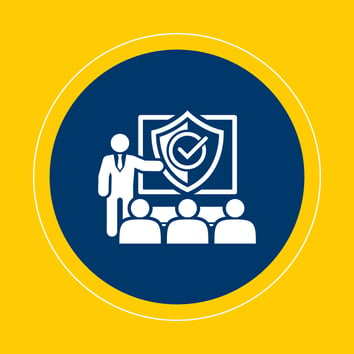Many people assume that large businesses make more tempting targets for cybercriminals than small to midsize businesses because they have more to lose. But attackers are all too aware of the fact that smaller businesses have lax security measures in place, making them a prime target for cybercriminals. In fact, according to Accenture's 2022 Cost of Cyber Crime report, 43% of all cyberattacks are aimed directly at small businesses. In addition, the same research found that only 14% of these small businesses have the proper safeguards in place to defend themselves.
If you’ve been lucky so far, it’s best not to press that luck much further. Here are six ways you can protect your organization.
1. Create a Multi-Layered Defense
We've entered an age where password protections and firewalls are not adequately keeping businesses safe from things like malware and phishing. Instead, a multi-layered defense is needed to stop a hacker from successfully infiltrating your network.
Additional layers include cybersecurity safeguards like account monitoring and multi-factor authentication (MFA), automated monitoring and alerting, next-generation anti-virus software that actively look for anomalous behavior (EDR), network segmentation, and data recovery capabilities. With these extra layers in place, you'll have more obstacles between the hackers and your company's information.
2. Add Offensive Testing
While planning may look good on paper, it is important that businesses take the next step and begin testing their defenses. This can be done by taking on the role of the malicious threat actor and going on the offensive in a controlled way.
Vulnerability assessments that actively test your environment will make sure that you have the ability to detect, respond, and recover from an incident the way you expect to. More often than not, this active testing will allow companies to gain valuable insights into current weaknesses that may have been overlooked. These findings can be used to create a roadmap to continue hardening their defenses and improving internal security-related processes.
3. Provide Employee Security Awareness Training
One of the most common methods of attack against SMBs is email. Through the use of malware attachments, it only takes a single employee clicking one malicious file in an email to begin infecting the entire company with malware. With attackers growing more sophisticated every day, it's more important than ever that your employees know how to spot these IT security breaches and how they should respond.
Phishing scams are also becoming more common and much harder to spot. According to Avast, 61% of Americans are highly vulnerable to phishing emails. However, ongoing security awareness training can transform your employees from one of your biggest liabilities to your best line of defense against hackers.
4. Increase Endpoint Security
BYOD (bring your own device) policies and hybrid or fully remote workplaces allow more flexibility, but they also require additional security solutions. Protecting all endpoints, from smartphones to laptops, is paramount to protecting your organization's network.
Patch management is only one element of proper endpoint security, but it’s one that frequently goes overlooked. Research shows that unpatched vulnerabilities are the cause of up to 60% of all data breaches.
5. Get a Security Assessment
If you haven’t updated your cybersecurity tools and strategies in the past few years, a Cybersecurity Assessment might be in order. At Marco, our cybersecurity experts work to identify vulnerabilities in your systems, tools, and practices. These findings result in an actionable plan that your organization can use to not only increase your security posture but also drastically reduce risks related to cybersecurity.
Unlike many others in the market, our Cybersecurity Assessment is more than just a vulnerability scan of your network. It is a holistic review of your core business systems, current protections and safeguards, and a proven process of reviewing your overall cybersecurity risk. Our approach allows us to build out a roadmap of recommendations that will give you the actionable steps necessary to make high-impact changes right away.
Is your organization currently meeting best practices when it comes to cybersecurity? We designed this interactive checklist based on recommendations from the National Institute of Standards and Technology Cybersecurity Framework (NIST CSF) to help small to midsize businesses see where they may be lacking key tools or policies.
6. Invest in Managed IT to Minimize Cybersecurity Risk Quickly and Easily
There is a cost associated with protecting your business from cyberattacks like malware, phishing, and ransomware, but it's important to balance that cost with the very real possibility of being a target of cybercrime. For instance, According to the US National Cyber Security Alliance, 60% of small businesses that have been attacked by a cybercriminal go out of business within six months.
With such high stakes, it is easy to see why having experienced IT security staff is so important. Unfortunately for small businesses, it can be difficult to find, train, recruit, afford, or retain IT security professionals. Partnering with a managed IT service provider allows smaller businesses a great option to make sure they have the security staffing that the modern threat landscape demands, while not breaking the bank.
Many providers, including Marco, set their rates based on the number of employees, so small business owners are often surprised by how affordable world-class protection can be.
To learn more about how to protect your business, download our Managed IT checklist below.
